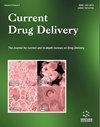Lignin Nanoparticles as pH-responsive Nanocarriers for Gastric-Irritant Oral Drug Aspirin
IF 3
4区 医学
Q2 PHARMACOLOGY & PHARMACY
引用次数: 0
Abstract
Introduction: Although lignin is one of the most naturally abundant biopolymers, the overall status of its utilization has long been subpar. The ability of Lignin to readily self-assemble into nanoparticles, along with its good biocompatibility and minimal toxicity, makes it a perfect agent for nanocarriers and drug delivery. Method: Hence, in this study, we have attempted to examine lignin nanoparticles (LNPs) as an efficient pH-responsive nanocarrier for gastric-irritant oral NSAID, aspirin. Alkali lignin (AL) was extracted from rice straw via alkaline treatment, and the lignin nanoparticles were synthesized from lignin using the acid precipitation method. The average particle size was 201.37 ± 1.20 nm, and the synthesized LNPs exhibited a spherical shape and smooth outer surface along with high polydispersity (PDI= 0.284 ± 0.012). The LNPs showed moderate hemocompatibility during in vitro hemolysis studies. The nanoparticles presented nearly similar chemical structures to the AL from which they were developed, and the FT-IR absorption spectra confirmed the similarity of this chemical structure to the LNPs and AL. Aspirin was successfully loaded into the LNPs with a satisfactory drug loading value of 39.12 ± 1.50 and an excellent encapsulation efficiency value of 91.44 ± 0.59. Results: Finally, the LNPs were capable of protecting the loaded drug at the acidic pH of the stomach (1.2) with just 29.20% release of the loaded aspirin after 10 h of observation in vitro. Contrarily, the LNPs were capable of rapidly releasing the aspirin at the basic pH of the intestine (7.4) with nearly 90% release of the loaded drug after 10 h observation in vitro. The basic pH of the intestine might lead to gradual dissociation of the LNPs followed by swift release of the loaded cargo. Conclusion: These findings substantiate that the LNPs carry the potential to be an apt and safe nanocarrier for oral drugs like aspirin as well as parenteral drugs, and LNPs can be utilized as an efficient alternative to enteric coating.木质素纳米颗粒作为胃刺激性口服药物阿司匹林的 pH 值响应型纳米载体
简介:虽然木质素是天然含量最高的生物聚合物之一,但长期以来其整体利用状况一直不尽如人意。木质素能够很容易地自组装成纳米颗粒,而且具有良好的生物相容性和极低的毒性,因此是纳米载体和药物输送的理想剂型。研究方法因此,在本研究中,我们尝试将木质素纳米颗粒(LNPs)作为一种有效的 pH 响应型纳米载体,用于胃刺激性口服非甾体抗炎药阿司匹林。研究人员通过碱性处理从稻草中提取了碱木素(AL),并采用酸沉淀法从木质素中合成了木质素纳米颗粒。合成的木质素纳米粒子平均粒径为 201.37 ± 1.20 nm,呈球形,外表面光滑,具有较高的多分散性(PDI= 0.284 ± 0.012)。在体外溶血研究中,LNPs 表现出适度的血液相容性。这些纳米颗粒的化学结构与 AL 相似,傅立叶变换红外吸收光谱证实了 LNPs 和 AL 的化学结构相似。阿司匹林被成功装载到 LNPs 中,药物装载值为 39.12 ± 1.50,非常令人满意,封装效率值为 91.44 ± 0.59。结果最后,LNPs 能够在胃的酸性 pH 值(1.2)下保护所负载的药物,体外观察 10 小时后,所负载的阿司匹林仅释放了 29.20%。相反,在肠道的碱性 pH 值(7.4)下,LNPs 能够快速释放阿司匹林,体外观察 10 小时后,负载的药物释放了近 90%。肠道的碱性 pH 值可能会导致 LNPs 逐渐解离,然后迅速释放所负载的货物。结论这些研究结果证明,LNPs 有潜力成为阿司匹林等口服药物和肠外药物的一种合适而安全的纳米载体,LNPs 可作为肠道包衣的一种有效替代品。
本文章由计算机程序翻译,如有差异,请以英文原文为准。
求助全文
约1分钟内获得全文
求助全文
来源期刊

Current drug delivery
PHARMACOLOGY & PHARMACY-
CiteScore
5.10
自引率
4.20%
发文量
170
期刊介绍:
Current Drug Delivery aims to publish peer-reviewed articles, research articles, short and in-depth reviews, and drug clinical trials studies in the rapidly developing field of drug delivery. Modern drug research aims to build delivery properties of a drug at the design phase, however in many cases this idea cannot be met and the development of delivery systems becomes as important as the development of the drugs themselves.
The journal aims to cover the latest outstanding developments in drug and vaccine delivery employing physical, physico-chemical and chemical methods. The drugs include a wide range of bioactive compounds from simple pharmaceuticals to peptides, proteins, nucleotides, nucleosides and sugars. The journal will also report progress in the fields of transport routes and mechanisms including efflux proteins and multi-drug resistance.
The journal is essential for all pharmaceutical scientists involved in drug design, development and delivery.
 求助内容:
求助内容: 应助结果提醒方式:
应助结果提醒方式:


